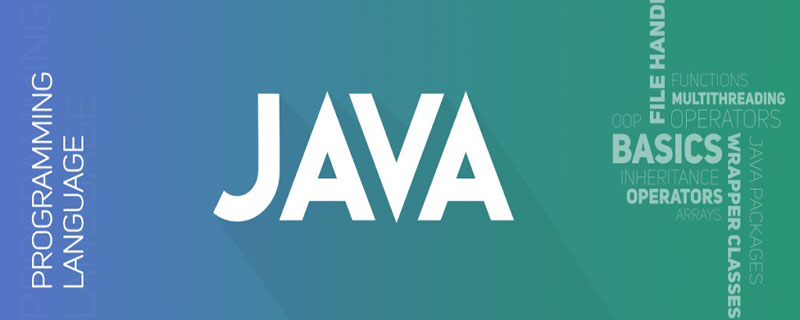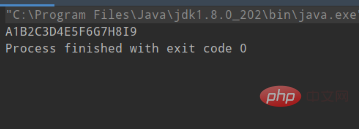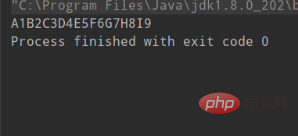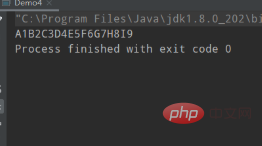Java는 교대로 인쇄하기 위해 두 개의 스레드를 구현합니다.
- 王林앞으로
- 2019-12-24 17:47:543492검색

ReentrantLock을 사용하여 두 스레드의 교대 인쇄 구현
앞에는 문자, 뒤는 숫자 구현
package com.study.pattern;
import java.util.concurrent.CountDownLatch;
import java.util.concurrent.locks.Condition;
import java.util.concurrent.locks.Lock;
import java.util.concurrent.locks.ReentrantLock;
public class Demo2 {
private static Lock lock = new ReentrantLock();
private static Condition c1 = lock.newCondition();
private static Condition c2 = lock.newCondition();
private static CountDownLatch count = new CountDownLatch(1);
public static void main(String[] args) {
String c = "ABCDEFGHI";
char[] ca = c.toCharArray();
String n = "123456789";
char[] na = n.toCharArray();
Thread t1 = new Thread(() -> {
try {
lock.lock();
count.countDown();
for(char caa : ca) {
c1.signal();
System.out.print(caa);
c2.await();
}
c1.signal();
} catch (InterruptedException e) {
e.printStackTrace();
} finally {
lock.unlock();
}
});
Thread t2 = new Thread(() -> {
try {
count.await();
lock.lock();
for(char naa : na) {
c2.signal();
System.out.print(naa);
c1.await();
}
c2.signal();
} catch (InterruptedException e) {
e.printStackTrace();
} finally {
lock.unlock();
}
});
t1.start();
t2.start();
}
}#🎜 🎜#최종 출력 결과:

java 교육 동영상#🎜🎜 #LinkedTransferQueue를 사용하여 두 개의 스레드를 교대로 인쇄
을 구현하여 앞의 문자와 뒤의 숫자를 얻습니다.
package com.study.pattern;
import java.util.concurrent.LinkedTransferQueue;
public class Demo3 {
private static LinkedTransferQueue<Character> linkedC = new LinkedTransferQueue<Character>();
private static LinkedTransferQueue<Character> linkedN = new LinkedTransferQueue<Character>();
public static void main(String[] args) {
String c = "ABCDEFGHI";
char[] ca = c.toCharArray();
String n = "123456789";
char[] na = n.toCharArray();
Thread t1 = new Thread(() -> {
for(char caa : ca) {
try {
linkedC.put(caa);
char a = linkedN.take();
System.out.print(a);
} catch (InterruptedException e) {
e.printStackTrace();
}
}
});
Thread t2 = new Thread(() -> {
for(char naa : na) {
try {
char b = linkedC.take();
System.out.print(b);
linkedN.put(naa);
} catch (InterruptedException e) {
e.printStackTrace();
}
}
});
t1.start();
t2.start();
}
}출력 결과:
#🎜🎜 #
#🎜 🎜#동기화를 사용하여 두 스레드의 교대 인쇄 실현 앞면의 문자와 뒷면의 숫자 실현
앞면의 문자와 뒷면의 숫자 실현
package com.study.pattern;
import java.util.concurrent.CountDownLatch;
public class Demo4 {
private static CountDownLatch count = new CountDownLatch(1);
public static void main(String[] args) {
String c = "ABCDEFGHI";
char[] ca = c.toCharArray();
String n = "123456789";
char[] na = n.toCharArray();
Object lock = new Object();
Thread t1 = new Thread(() -> {
synchronized (lock) {
count.countDown();
for(char caa : ca) {
System.out.print(caa);
lock.notify();
try {
lock.wait();
} catch (InterruptedException e) {
e.printStackTrace();
}
}
lock.notify();
}
});
Thread t2 = new Thread(() -> {
try {
count.await();
} catch (InterruptedException e) {
e.printStackTrace();
}
synchronized (lock) {
for(char naa : na) {
System.out.print(naa);
lock.notify();
try {
lock.wait();
} catch (InterruptedException e) {
e.printStackTrace();
}
}
lock.notify();
}
});
t1.start();
t2.start();
}
}출력 결과: # 🎜🎜#
# 🎜🎜#
LockSupport를 사용하여 두 스레드의 교대 인쇄 실현앞의 문자와 뒤의 숫자 실현package com.study.pattern;
import java.util.concurrent.locks.LockSupport;
public class Demo5 {
private static Thread t1;
private static Thread t2;
public static void main(String[] args) {
String c = "ABCDEFGHI";
char[] ca = c.toCharArray();
String n = "123456789";
char[] na = n.toCharArray();
t1 = new Thread(() -> {
for(char caa : ca) {
System.out.print(caa);
LockSupport.unpark(t2);
LockSupport.park();
}
});
t2 = new Thread(() -> {
for(char naa : na) {
LockSupport.park();
System.out.print(naa);
LockSupport.unpark(t1);
}
});
t1.start();
t2.start();
}
}  출력 결과:
출력 결과:
추천 관련 기사 및 튜토리얼:
java 0 기반 항목
위 내용은 Java는 교대로 인쇄하기 위해 두 개의 스레드를 구현합니다.의 상세 내용입니다. 자세한 내용은 PHP 중국어 웹사이트의 기타 관련 기사를 참조하세요!
성명:
이 기사는 csdn.net에서 복제됩니다. 침해가 있는 경우 admin@php.cn으로 문의하시기 바랍니다. 삭제
이전 기사:Java에서 비교기와 비교기의 차이점다음 기사:Java에서 비교기와 비교기의 차이점

